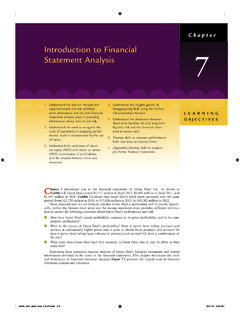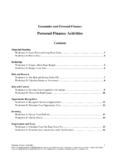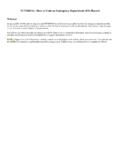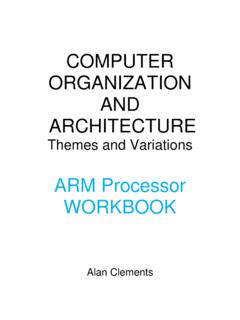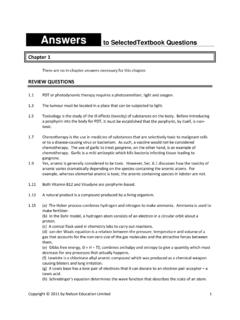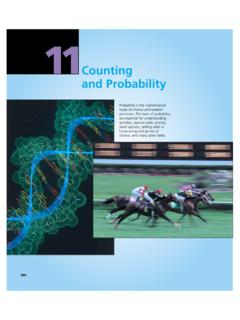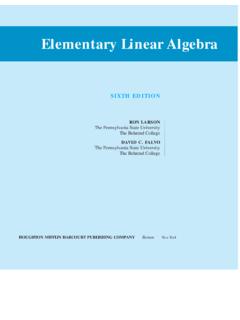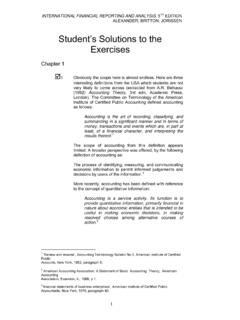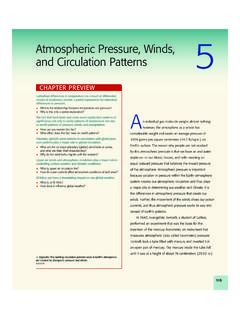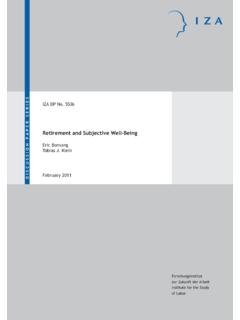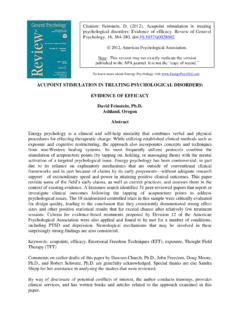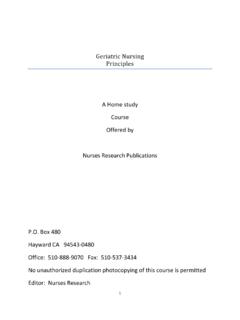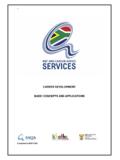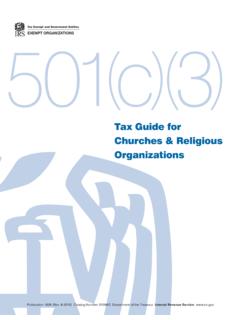Transcription of PENALTY TAXES ON CORPORATE ACCUMULATIONS
1 H Chapter Six H. PENALTY TAXES ON CORPORATE . ACCUMULATIONS . INTRODUCTION AND STUDY OBJECTIVES. The accumulated earnings tax and the personal holding company tax are PENALTY TAXES designed to prevent taxpayers from using the corporation for tax avoidance. Both TAXES are imposed on unwarranted ACCUMULATIONS of income that would have been taxable to the individual if it had been distributed. The purpose of the two PENALTY TAXES is to compel distributions, thereby discouraging taxpayers from using the corporation for tax avoidance purposes. In studying the rules of CORPORATE ACCUMULATIONS , the student should have these objectives: 1. To learn the rules related to the assessment of the accumulated earnings PENALTY tax. 2. To learn the rules related to the imposition of the personal holding company PENALTY tax.
2 3. To understand when the rules of both PENALTY TAXES will be applied. 4. To become familiar with various methods that are available to the taxpayer to avoid assessment of the PENALTY . STUDY HIGHLIGHTS. ACCUMULATED EARNINGS TAX. 1. The accumulated earnings tax is a PENALTY tax designed to discourage the excessive accumulation of earnings by a corporation. The tax aims at forcing the corporation to distribute its earnings to the shareholders, who then in turn pay TAXES on dividend income. Whether income is being accumulated for the forbidden purpose of avoiding TAXES requires a determination of the taxpayer's intent. 2. The accumulated earnings tax is calculated as follows: Taxable income The dividends-received deduction The net operating loss deduction Capital loss carryovers included in taxable income Federal income TAXES (excluding PENALTY TAXES ).
3 Charitable contributions in excess of the 10% limitation Net capital losses incurred during the year Net LTCG over Net STCL (net of TAXES ). Accumulated taxable income Accumulated earnings credit Dividends-paid deductions Accumulated taxable income 15. Accumulated earnings PENALTY tax For tax years beginning after 2002 (as extended each year) the PENALTY tax is 15%. 6-1. 6-2 PENALTY TAXES on CORPORATE ACCUMULATIONS Example. J corporation, a nonservice company, has the following transactions during the year. Taxable income $450,000. Tax liability 150,375. Excess charitable contributions 33,000. Short-term capital loss (60,000). Dividends received 150,000. Dividends paid 60,000. Accumulated earnings from prior years 220,000. Assuming no reasonable business needs to justify additional ACCUMULATIONS , the 531 PENALTY tax is calculated as follows: Taxable income $450,000.
4 Plus: 80% Dividends-received deduction 120,000. $570,000. Less: Tax liability (150,375). Excess charitable contribution (33,000). Net short-term capital loss (60,000). Dividends paid (60,000). Remaining accumulated earnings credit (30,000). ($250,000 $220,000). Accumulated Taxable Income $236,625. The PENALTY tax for the year would be ($236,625 15%) $35,494. 3. The accumulated earnings credit is a reduction in arriving at accumulated taxable income. The amount of the credit is the greater of: l $250,000 minus the accumulated earnings and profits at the end of the prior year, or l The current earnings and profits retained for the reasonable needs of the business minus net LTCG. over set STCL (net of TAXES ). 4. The accumulated earnings credit is reduced to $150,000 for corporations primarily engaged in the business of providing professional services ( , accountants, attorneys, engineers, etc.)
5 5. The dividends-paid deduction comprises the following dividends: l Dividends paid during the taxable year not previously used. l Dividends paid within months after the close of the taxable year. l Consent dividends. l Liquidating dividends. Study Highlights 6-3. 6. Consent dividends are not actually paid to the shareholders; nonetheless, the shareholders must include them in computing their taxable income as if they had received an actual distribution. A consent dividend will increase the basis of the shareholder's stock. 7. Reasonable business needs is not defined in the code. The Regulations state that reasonable business needs include l Capital for bona fide expansion of the business. l Provisions for the retirement of bona fide indebtedness.
6 L Reserves for pending litigation. l Investments or loans to suppliers. l Provisions for working capital needs. 8. The courts have developed an operating-cycle approach to determine the working capital needs of a business. This approach, known as the Bardahl formula, permits an accumulation equal to the cost of operating a business for a single operating cycle. See Example 6 in the textbook for an excellent illustration. 9. Because the ACCUMULATIONS tax is assessed upon the shareholder's intent, the need for the PENALTY is based upon a subjective assessment. The burden of proof is generally placed upon the taxpayer; however, the burden can be shifted to the IRS. To shift the burden, the corporation must respond within 60 days after a notice is received from the IRS requesting information as to the reasonableness of the corporation's accumulation of earnings.
7 PERSONAL HOLDING COMPANY. 10. The personal holding company tax is aimed at so-called incorporated pocketbooks and incorporated talent. These are corporations established to receive and hold investment income or compensation of its shareholders in order to shield that income from the higher individual tax rates that would apply had the income been received by the shareholders. 11. Certain companies are exempt from the personal holding company PENALTY tax. These include banks, savings and loan associations, most finance companies, and life insurance and surety companies. 12. A personal holding company is any corporation that meets both of the following tests: a. Ownership: At any time during the last half of the taxable year more than 50 percent of its outstanding stock is owned, directly or indirectly, by up to five individuals.
8 B. Passive income: At least 60 percent of the corporation's adjusted ordinary gross income (AOGI). consists of personal holding company income (PHCI). 13. The attribution rules of 544 are used in determining the stock ownership test. 14. AOGI is calculated as follows: Gross income Capital gains 1231 gains Ordinary gross income (OGI). Deductions related to rental and royalty income Adjusted ordinary gross income (AOGI). 6-4 PENALTY TAXES on CORPORATE ACCUMULATIONS 15. PHCI is essentially passive income such as dividends, interest, rents, and royalties. However, in some cases, amounts received under personal service contracts or as compensation for the use of CORPORATE property by shareholders are also included in PHCI. See Chapter 6, Exhibit 8 in the textbook for a more thorough description.
9 16. Rental income is normally classified as PHCI. However, if two specific tests are met, adjusted rents (gross rents minus directly related expenses) are excluded from the PHCI category. The test for exclusion requires that both of the following be met: a. 50 percent or more of the corporation's AOGI is adjusted income from rents. b. Dividends paid during the year equal or exceed nonrent PHCI minus 10 percent of OGI. Example. N Corporation has gross income for the year of $40,000, which includes $30,000 in rental income, $8,000 in dividends, and a $2,000 long-term capital gain. Expenses related to the rental income are $20,000 and the company paid dividends of $5,000. AOGI must be calculated first: Gross income $40,000. Capital gain (2,000). OGI $38,000.
10 Rental expenses (20,000). AOGI $18,000. Next adjusted income for rents must be 50 percent or more of AOGI: Rental income $30,000. Rental expenses (20,000). Adjusted income from rents $10,000. 50% of AOGI ($18,000) 9,000 TEST I satisfied Next dividends paid must exceed nonrent PHC minus 10 percent of OGI: Nonrent PHC income $8,000. 10% of OGI (3,800). Excess $4,200. Dividends paid $5,000. Since both tests are satisfied, the company is allowed to exclude rental income (net of expenses) in determining the amount of passive income for the year. Accordingly, PHCI amounts to $8,000 (dividends only). 17. Additional tests exist to exclude adjusted income from mineral oil and gas royalties as well as compensation for the use of property by a shareholder. Study Highlights 6-5.
